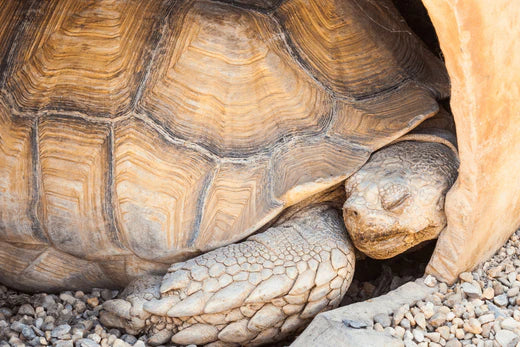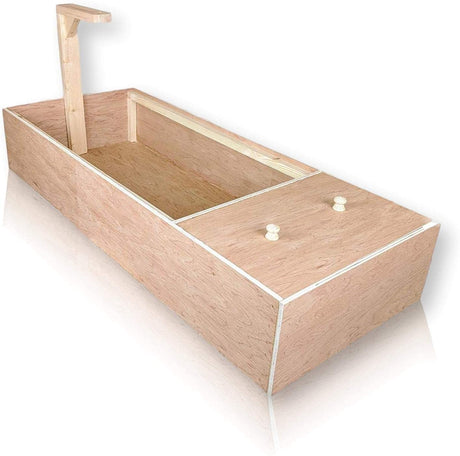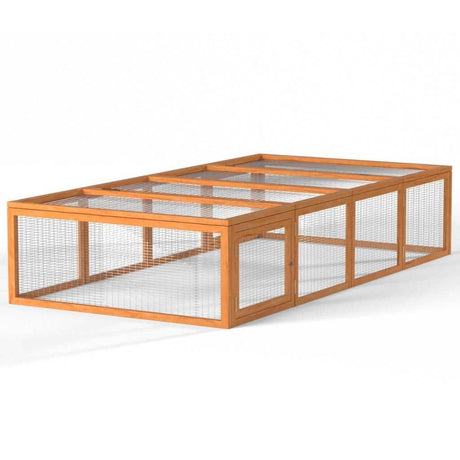If you are a tortoise owner in the UK, you are probably aware that the conditions you provide for your exotic pets are very different to those that they will experience in the wild. Hibernation is just one of the many things you need to consider as a tortoise owner. But what is tortoise hibernation and how do you make sure you do it safely?
What is Hibernation?
Hibernation is a normal process that many wild animals undergo to avoid the cold weather. When food is scarce, sunlight is limited, and the temperature drops, these animals need to hibernate in order to survive.
Although it may seem like a hibernating animal is asleep, it is not the kind of sleep that they would experience each night. All of their metabolic processes slow down in an attempt to save energy and survive the winter; their body keeps functioning but at incredibly slow rates to keep them alive until the environmental conditions are more favourable.
Do Tortoises Hibernate?
Tortoises need warmth to be able to complete their normal body functions and so when the temperature drops they are not able to generate the energy needed to survive.
The process which tortoises undergo is not technically called hibernation but is something known as brumation. They will slow their metabolic processes down so much that it will seem like they are no longer alive.

Tortoises Hibernating in the Wild
In the wild, tortoises will detect the change in temperature and will naturally begin the process of preparing for hibernation. This includes several things that you will likely also notice when preparing your tortoise for hibernation in captivity, too.
Changes in Appetite
At first, a wild tortoise will eat more to ensure he is well hydrated and generate healthy energy stores within the body. Then, as the temperature drops, their appetite will decrease and they will slowly starve themselves, emptying their stomach of any food. If there was food left in their stomach throughout hibernation, it would rot which could cause serious issues.
Emptying Their System
Following on from our previous point, tortoises will empty their systems of any waste so as to maintain a healthy digestive tract.
They will defecate and urinate much more frequently in the time before their hibernation period. It is common to see tortoises basking in the sunlight right up until the day of hibernation to stimulate their systems and produce any waste. You’re also a lot more likely to see more tortoise faeces and urates in areas that tortoises frequent as the temperatures begin to drop.
Location
It is very important for a hibernating tortoise to first look for a safe and secure area to complete their hibernation. Tortoises will dig a hole in preparation for the hibernation period however sometimes it will be stolen by another tortoise or even by another species of animal.

Drinking Water
The water intake of a tortoise preparing for hibernation will increase before they enter the den in a last attempt to empty their digestive system. If you notice a tortoise wanting to drink a lot more as the temperatures drop, it could be that they are in the last stage of their hibernation process.
Which Species Hibernate in the Wild?
Not all tortoises hibernate naturally. Depending on their natural habitat and the environmental conditions in the wild, some species can go their whole lives without the need to hibernate. However, if the environmental temperature drops too low then tortoises cannot complete their basic metabolic functions.
Generally speaking, Mediterranean tortoises will hibernate each year because the temperatures fluctuate and they will experience relatively cool winters where it remains cold for an extended period of time, in which a tortoise could not survive. Tropical tortoises, on the other hand, will not usually hibernate as the temperatures stay warm all year round, thus providing tortoises with enough energy to be able to avoid hibernation.
Hibernating species of tortoises include:
- Spur-thighed tortoise (Testudo graeca)
- Russian tortoise (Testudo horsfeldii)
- Marginated tortoise (Testudo marginata)
- Hermann’s tortoise (Testudo hermanni)
If you are looking to hibernate your tortoise then make sure you do your research to see if that particular species is one that will hibernate in the wild. If you were to try and hibernate a tortoise that does not naturally hibernate, you could make them sick and they could even die.
Pet Tortoise Hibernation
As tortoise owners, you should naturally be concerned about the process of hibernation because, if it is not done correctly, it could be dangerous for your tortoise. Do your research on when to hibernate your tortoise, and when not to!
When You Shouldn’t Hibernate Your Tortoise
Whether or not you let your tortoise hibernate can be determined by several factors. Here are a few reasons you should not consider hibernating your tortoise.
Species
As we have mentioned previously, before hibernating your tortoise, you should first check if it is a species of tortoise that would naturally hibernate in the wild. If it would not hibernate in the wild, such as a leopard tortoise or a red-footed tortoise, then under no circumstances should you attempt to hibernate them in captivity.
Sickness
You should never hibernate a sick tortoise as it may not survive an extended period of reduced food and metabolic function. If your tortoise is sick, the best thing to do is to take them to the vets who can provide a treatment plan to help them recover.

Weight
Weigh your tortoise on a regular basis and you can easily begin to monitor their health and determine whether or not they are ready to hibernate. Although an underweight tortoise will not be ready to hibernate, a tortoise with too much body fat could also run into some serious problems should they hibernate. You can check the desired weight before hibernation in reference to their size using the Jackson ratio.
Age
It is recommended to not hibernate your tortoise until it is at least 3 years of age. You should check what the recommended weight, size, and age are for your specific species of a tortoise before thinking about hibernation.
How to Hibernate Your Tortoise Safely
If you have considered all of the points above, and you have consulted your vet about your tortoise’s health and the hibernation process, then it’s time to learn about how to hibernate your tortoise safely.
What to Expect
You can expect to see your tortoise showing the same signs that we outlined in regards to tortoises hibernating in the wild. Expect changes in appetite, an increase in water consumption, and behaviours that suggest they are looking for a safe space to hibernate. You will also notice lots more defecation, so be sure to keep their environment clean and sanitary as they prepare for the process.

When
By the end of August, you should know whether or not your tortoise is ready to hibernate. If your tortoise is underweight or is showing signs of any underlying health problems, then they will not be ready to hibernate in a few months time.
If they are in optimum health, have healthy body weight, and have no signs of respiratory infection, abscesses, mouth rot, or anything else that could affect their hibernation, then you should be ready to prepare them for the process.
Tortoise hibernation often begins from October to November, and most species will hibernate until the following spring. Hibernation time depends on the environmental conditions as well as the health, size, and age of your tortoise.
A younger tortoise may only hibernate for a few weeks in captivity, whereas an older tortoise can last from November until March, quite happily. Consult with your vet and do your research to determine what is best for your pet tortoise.
Preparing Your Tortoise for Hibernation
Even before it is time to consider hibernating, you should be feeding your tortoise a balanced diet throughout the summer months to maintain their health and increase their chances of a successful hibernation.
If you decide to allow your tortoise to hibernate, depending on the size and age of your tortoise, they should go through a period of fasting that should last between three and six weeks. You should consult your vet to calculate the ideal amount of time for your specific pet tortoise.
After their last meal, your tortoise should be kept at a constant temperature of around 12 degrees Celsius to allow their food to be properly digested whilst stimulating the natural behaviours of hibernation.
Bathe them regularly and provide them with plenty of drinking water to aid digestion and to ensure that they stay hydrated.
As it gets close to the time of hibernation, you should gradually reduce their simulated daylight hours, to mimic the reduced hours of sunlight they would see in the winter months in the wild.
Methods of Hibernating Your Tortoise
There are several different methods in which you can hibernate a tortoise, some are easier than others, but you should be able to choose a method that works for you and will allow you to hibernate your pet tortoise safely.

Method 1: Fridge Method
The fridge method is a popular way of hibernating your pet tortoise because you can easily monitor the temperature and keep it constant throughout your tortoise’s hibernation.
- Make sure you have a separate fridge for your tortoise so as not to contaminate your food and drinks.
- Find a plastic tub that is large enough that your tortoise can turn around in, and deep enough that it can cover itself with substrate. You can use an ice cream tub or something similar for this, just be sure to clean it out thoroughly before using it for your tortoise’s hibernation.
- Fill the tub with sterilised soil and make ventilation holes to improve air flow.
- Place the tub, with your tortoise inside, into the fridge and keep the temperature between 3 and 7 degrees Celsius at all times.
- You do not want the temperature to vary too much at all; by placing 2-litre bottles of water inside it can help stabilise the temperature and avoid any fluctuations.
- Open the fridge door several times a week to encourage air flow, and avoid suffocation.
Method 2: Box Method
While you can buy a specially made hibernation box, these are not always necessary and you can just as easily fashion one out of boxes you will have around the house.
- Place your tortoise in a small box that is large enough for your tortoise to turn around and bury itself in. Small tortoises could likely even fit in a margarine tub.
- Make air holes, fill it with soil, and allow your tortoise to dig themselves under the substrate.
- Place this secure box inside a larger cardboard box that is filled with a product such as styrofoam peanuts, shredded paper, or wood chippings, that will insulate the box within.
- With this method, you won’t want to disturb your tortoise or keep on opening the lid as this will cause the temperature to fluctuate, so use a temperature probe or a wireless thermometer to monitor the temperature within.
- Place the two boxes in a cool room such as a garage or a shed. Make sure they are safe from predators and pests.
Method 3: Natural Method
The natural method would entail not really doing anything at all to manage your tortoise’s hibernation, aside from the preparatory stuff. If your tortoise lives outside, then you can leave them to bury themselves and begin their hibernation, however, in the UK this is not recommended as the temperatures fluctuate so much and they will be at risk from predators and pests such as foxes, cats, and rats.
During Hibernation
No matter the method, you should check on your tortoise to ensure the temperature is within 3 and 7 degrees Celsius, that there is sufficient airflow, and that they are not beginning to wake up too soon.
Weigh them frequently to monitor weight loss and ensure they are maintaining a healthy weight. Naturally, your tortoise should lose 1% of its body weight during each month of hibernation. Therefore, if your tortoise is 1kg, you should expect them to lose 10g in the first month.
If they lose too much weight too fast, you should consult your vet immediately and be prepared to bring them out of hibernation early.
If you check on your tortoise and you notice they have urinated, you should wake them up as they could be at risk of dehydration.
Bringing Them Out of Hibernation
To wake up your tortoise, remove your tortoise hibernation box from its designated area and place it somewhere warmer. The increase in temperature should stimulate your tortoise to begin moving around more.
Take your tortoise out of their box and bathe them in a shallow dish in lukewarm water to flush out any toxins and encourage them to drink. After a while, you can place them back into their tortoise table and allow them to move in and out of the glare from the heat lamp.
Most tortoises will drink fairly soon after coming out of hibernation but monitor them, and if they do not drink after a few days you should consult your vet.
The same goes for eating, and you should call your vet after one week of not consuming any food.
Hibernating a Tortoise
If you have a pet tortoise and you’re considering hibernating them this winter, make sure you do your research so you can properly prepare them for such a delicate period of time. If not done correctly, your tortoise may not survive this period of dormancy so always consult with your vet before going through with the process.
With careful consideration and the right conditions, there is no reason why you cannot successfully hibernate a tortoise each year.
Let us know if you have any questions!





6 comments
I have an outdoor Greek tortoise who has naturally hibernated for her first 2 Winters. This year she hasn’t buried herself but is not moving or eating. She is in her usual burrowing place in the dark but just not buried. Any suggestions??
I have 2baby tortoises don’t know how old I know have indoors in a enclosed should they hibinate I have 3large ones which have had 72years and know how to keep them but don’t know what to do with the babies they could be 4years old they both weigh 1lb 10 ounce s I have a light for warms or a nvs or nvb which one do I use for winter they do want to sleep but not sure what to do
I wish I had researched how tortoises hibernate sooner. I was told not to let hatchlings hibernate the first year. For three years been taking care of sulcata hatchlings taking em out to get sun in the daytime then bringing in at night and putting heating pad under one side of enclosure when cold. Last spring decided I didn’t have room for them inside and been working on enclosure outdoors. I had made them a house out of mud and grass to keep them cool during the summer here in Arizona. Rained really good this week and their house started to collapse and rising water flooded it so I had to get em out. One was missing and ended up tearing apart torties mound to find him. Now it’s getting cold at night and was trying to figure what temperature is too low and when to start bringing em in at night. Built a new better house with insulation and added a lamp for more warmth but still worried about hatchlings. I have two hatchlings this year, five from last year and five from year before. Now I read this article and realize I been doin this all wrong, poor babies!
I have never hibernated my tortoises I think I am going to leave it one more year because I don’t think they are old enough and one is very small and clearly not ready and I am trying to learn a head of time so I know what to do.
Iput my 3 1/2 yr old horsefield in a deep box wth soil and hay type bedding on saturday after the proper starving and daily bathing today monday I can hear her scratching a lot inside the box after being quiet until now what should i do please
My tortoise like to bury himself in the compost bag is it safe to leave him there in a box when I hibernate him. I usually put him newspapers in a cardboard box